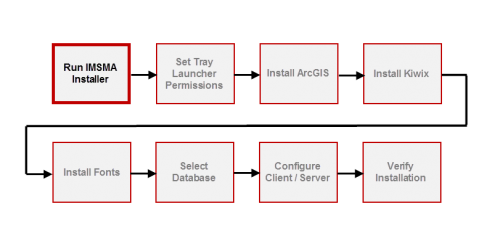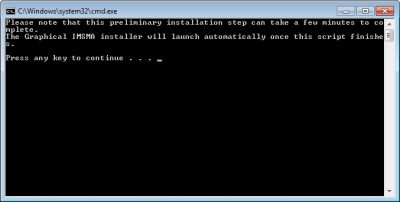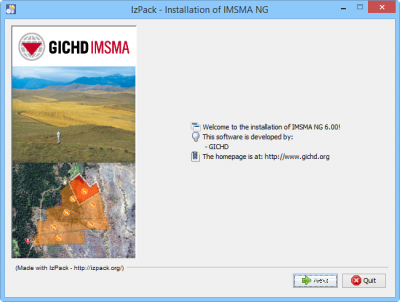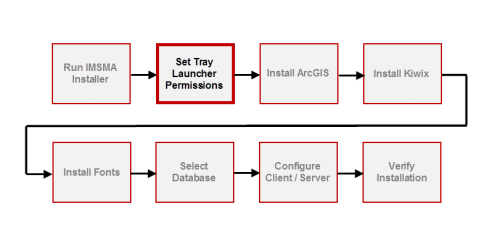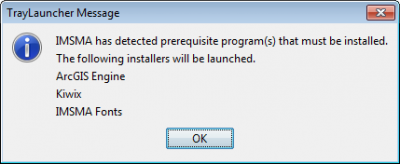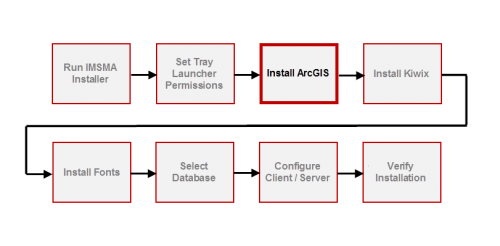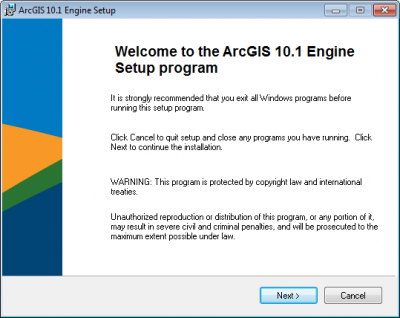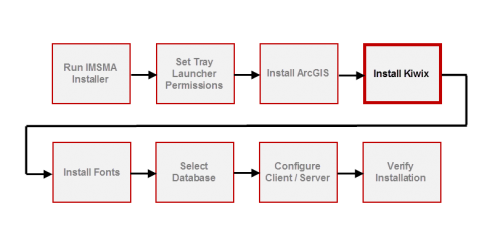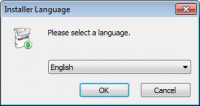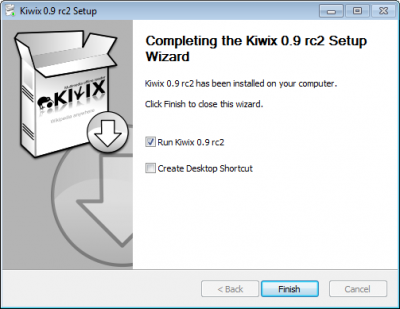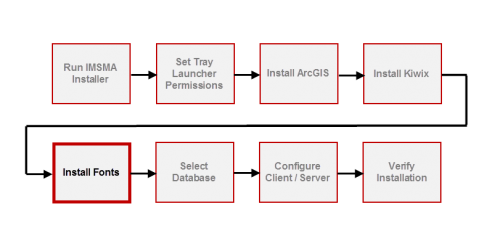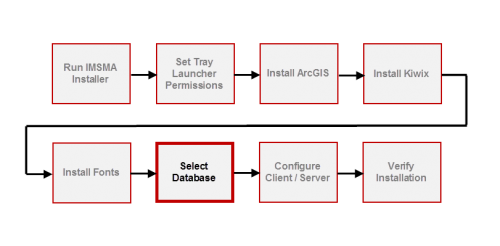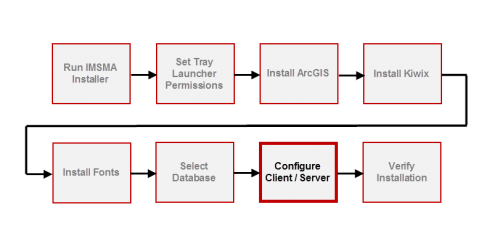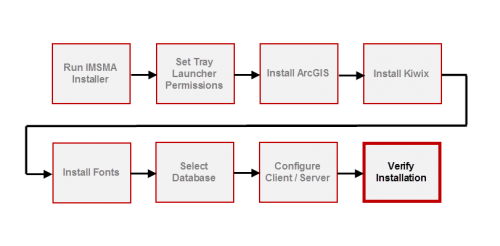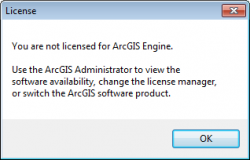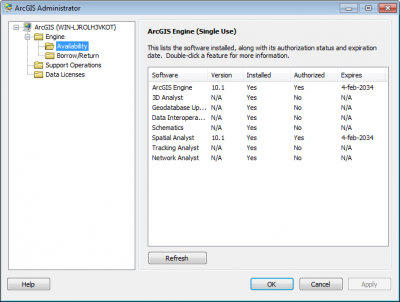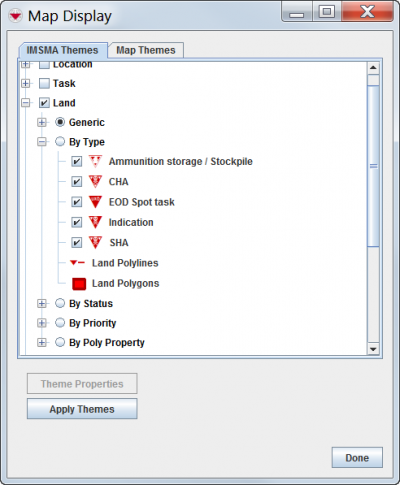Difference between revisions of "Installer IMSMANG version 6"
(Created page with "{{note|This page will include French translation of the installation instructions}}") |
|||
| Line 1: | Line 1: | ||
{{note|This page will include French translation of the installation instructions}} | {{note|This page will include French translation of the installation instructions}} | ||
| + | |||
| + | {{TOC right}} | ||
| + | |||
| + | ==Exigences de l’ordinateur== | ||
| + | L’ordinateur executant {{IMSMANG}} peut avoir l'un des systèmes d'exploitation suivants: | ||
| + | * Windows® XP Professional 32 bits Service Pack 3 et pour 64 bits Service Pack 2 | ||
| + | * Windows Vista | ||
| + | * Windows 7 | ||
| + | * Windows 8 (Il y a quelques étapes supplémentaires spécifiques qui doivent être effectuées pour [[Windows 8]]) | ||
| + | * Windows Server 2003 | ||
| + | * Windows Server 2008 | ||
| + | * (Windows Server 2012) | ||
| + | |||
| + | Pour plus de détails concernant les spécifications techniques cliquez [[Technical Specification Equipment | ici]]. | ||
| + | |||
| + | {{note| {{IMSMANG}} v 6.0 n'a pas été testé intensivement sur Windows 2012. Veuillez communiquer avec votre conseiller IM au CIDHG avant d'installer {{IMSMANG}} sur Windows 2012.}} | ||
| + | |||
| + | ==1ère Partie: Exécuter le programme d’installation {{IMSMANG}}== | ||
| + | |||
| + | [[Image:InstallationGuideStep1.png|center|500px|''Running the IMSMA Installer'']] | ||
| + | |||
| + | [[Image:Cmd NG.png|center|400px]] | ||
| + | |||
| + | |||
| + | <ol> | ||
| + | <li>Double-cliquez sur le fichier '''Install_IMSMA.exe''' dans le package d’installation.</li> | ||
| + | <li>Lorsque la fenêtre de commande s'affiche, suivez les instructions. | ||
| + | |||
| + | [[Image:Graphic NG.png|center|200px]]</li> | ||
| + | |||
| + | <li>Dans la fenêtre de sélection de la langue, sélectionnez la langue que vous souhaitez utiliser lors de l'installation et cliquez sur '''OK'''. | ||
| + | |||
| + | [[Image:1st panel NG.png|center|400px]]</li> | ||
| + | |||
| + | <li>Parcourez les écrans d'installation de l'installateur graphique, comme décrit ci-dessous:<ol> | ||
| + | <li>Dans l’écran d'acceuil, cliquez '''Next'''.</li> | ||
| + | <li>Sélectionnez l’option ''I accept the terms of this license agreement'' et cliquez sur '''Next'''.</li> | ||
| + | <li>Nous vous recommandons fortement d’utiliser le chemin d’installation par défaut pour {{IMSMANG}}. Cliquez sur '''Next'''.</li> | ||
| + | <li>Si le dossier cible n'existe pas déjà un message sera alors affiché, cliquez sur '''OK'''.</li> | ||
| + | <li>Sur l'écran de sélection des packages, cliquez sur '''Next'''.</li> | ||
| + | <li>Attendez que la barre de progression de l’installation se termine, ensuite cliquez sur '''Next'''.</li> | ||
| + | <li>Lorsque l’écran de Setup Shortcuts s’affiche, cliquez sur '''Next'''.</li> | ||
| + | <li>Lorsque l’installation est terminée, cliquez sur '''Done'''. | ||
| + | |||
| + | |||
| + | {{note | Lorsque l'installateur graphique a terminé la mise au point remonte à la fenêtre de commande et les prochaines étapes de l'installation continuent donc s'il vous plaît ne pas fermer la fenêtre de commande.}}</li></ol> | ||
| + | </li> | ||
| + | |||
| + | <li>Lorsque la fenêtre de commande apparaîtra, appuyez sur n'importe quelle touche du clavier pour continuer.</li> | ||
| + | </ol> | ||
| + | |||
| + | ==2ème Partie: Définir des autorisations pour le Tray Launcher== | ||
| + | |||
| + | [[Image:InstallationGuideStep2.png|center|500px|''Setting Tray Launcher Permissions'']] | ||
| + | <div align="center"> | ||
| + | </div> | ||
| + | |||
| + | #Sur votre ordinateur, faites un clic droit sur l’icône IMSMA Tray Launcher et sélectionnez l'option des '''Properties'''. | ||
| + | #Dans la fenêtre des propriétés d’IMSMA Tray Launcher, sélectionnez l’onglet de '''Shortcut''', ensuite cliquez sur '''Advanced'''. | ||
| + | #Dans la fenêtre des propriétés avancées, vérifiez '''Run as administrator''' checkbox, ensuite cliquez sur '''OK'''. | ||
| + | : Il est important d'utiliser ''Run as administrator'' la première fois que {{IMSMANG}} se démarré puisque d'autres programmes d'installation seront déclenchées. Dépendant sur le nombre de permissions d’utilisateurs sont limités, il serait préférable de ne pas exécuter en tant qu’administrateur. | ||
| + | #Retour dans la fenêtre des propriétés IMSMA Tray Launcher, cliquez sur '''OK'''. | ||
| + | |||
| + | Il est important de définir cette propriété puisque vous allez commencer d'autres applications avec le Tray Launcher. | ||
| + | ==3ème Partie: Installer le support de logiciel== | ||
| + | <ol> | ||
| + | <li>Sur votre ordinateur, double-cliquez sur l’icône IMSMA Tray Launcher. | ||
| + | |||
| + | [[Image:Support SW.png|center|400px]]</li> | ||
| + | |||
| + | |||
| + | |||
| + | <li>2. Si un logiciel ou des polices de support doivent être installés, un message s'affichera pour vous avertir ceux qui sont nécessaires. Cliquez sur '''OK''' pour lancer le(s) processus.</li> | ||
| + | </ol> | ||
| + | ===Partie 3A: ArcEngine 10.1=== | ||
| + | |||
| + | [[Image:InstallationGuideStep3.png|center|500px|''Installing ArcGIS'']] | ||
| + | <div align="center"> | ||
| + | </div> | ||
| + | |||
| + | [[Image:ArcEngine10.1.png|center|400px]] | ||
| + | |||
| + | #Sur l’écran d’accueil, attendez que la configuration calcule les besoins en espace, ensuite cliquez sur '''Next'''. | ||
| + | #Dans la fenêtre d'accord de licence, sélectionnez l’option ''I accept the license agreement'', ensuite cliquez sur '''Next'''. | ||
| + | #Dans la fenêtre de sélection du type d’installation, vérifiez que l’option '''Complete''' est sélectionnée, ensuite cliquez sur '''Next'''. | ||
| + | #Dans la fenêtre Destination Folder, cliquez sur '''Next'''. | ||
| + | #Dans la fenêtre Python Destination Folder, cliquez sur '''Next'''. | ||
| + | #Dans la fenêtre Ready to Install the Application, cliquez sur '''Next'''. | ||
| + | #Sur l’écran Updating System, attendez que la barre de progression se termine. | ||
| + | #Lorsque ArcGIS a été installé, cliquez '''Finish'''. | ||
| + | |||
| + | Si le programme d’installation ne démarre pas automatiquement, vous pourrez le retrouver ici: C:\IMSMAng\trayLauncher\exe\ArcGISEngine. | ||
| + | |||
| + | .Net 3.5 est une condition préalable à l’installation d’ArcEngine, s’il n’est pas installé sur l’ordinateur vous pourrez télécharger le programme d’installation ici: '''[http://mwiki.gichd.org/mediawiki/images/0/00/dotnetfx35sp1.zip dotnetfx35sp1.zip]''' | ||
| + | |||
| + | ===Partie 3B: Kiwix=== | ||
| + | |||
| + | [[Image:InstallationGuideStep4.png|center|500px|''Installing Kiwix'']] | ||
| + | |||
| + | [[Image:Graphic Kiwix.png|center|200px]] | ||
| + | |||
| + | |||
| + | <ol> | ||
| + | <li>Sur le dialogue d’installeur de langue, sélectionnez la langue que vous voulez utiliser lors de l’installation, et ensuite cliquez sur '''OK'''.</li> | ||
| + | <li>Lorsque l’écran de configuration de Kiwix s’affiche, cliquez sur '''License Agreement'''.</li> | ||
| + | <li>Après avoir lu le License agreement, cliquez sur '''I Agree'''.</li> | ||
| + | <li>Cliquez sur '''Next'''.</li> | ||
| + | <li>Sur l’écran d’installation, attendez que la barre de progression se termine, et ensuite cliquez sur '''Next'''. | ||
| + | |||
| + | [[Image:Kiwix.png|center|400px]]</li> | ||
| + | |||
| + | <li>Lorsque Kiwix été installé sur votre ordinateur, désélectionner '''Start Kiwix''' et cliquez sur '''Finish'''.</li> | ||
| + | </ol> | ||
| + | |||
| + | Si le programme d’installation ne démarre pas automatiquement, vous pourrez le retrouver ici: C:\IMSMAng\trayLauncher\exe\Kiwix\install | ||
| + | |||
| + | ===Partie 3C: Fonts/Polices=== | ||
| + | |||
| + | [[Image:InstallationGuideStep5.png|center|500px|''Installing Fonts'']] | ||
| + | |||
| + | |||
| + | [[Image:Font.png|center|200px]] | ||
| + | |||
| + | |||
| + | Les fichiers des polices '''IMSMA 2006.ttf''', '''IMSMA 2006 2.ttf''', '''IMSMA2009.ttf''' et '''IMSMA2013.ttf''' seront installés sur votre ordinateur. | ||
| + | |||
| + | ==4ème Partie: Database/Base de Données== | ||
| + | |||
| + | [[Image:InstallationGuideStep6.png|center|500px|''Selecting Database'']] | ||
| + | <div align="center"> | ||
| + | </div> | ||
| + | |||
| + | Si vous n’avez pas de base de données à restaurer vous devrez donc vous créez une base de données IMSMA initiale. Si vous effectuez l’installation sur Windows 8 veuillez-vous référer à cette '''[[Windows 8|page]]''' avant de restaurer ou de créer une nouvelle base de données. | ||
| + | ===Base de données Initiales=== | ||
| + | |||
| + | Pour créer une base de données initiale: | ||
| + | #Ouvrez le dossier '''c:\imsmang\database'''. | ||
| + | #Double-cliquez sur le fichier '''install_initial.bat'''. | ||
| + | #Sur la fenêtre des commandes, appuyez sur n'importe quelle touche pour démarrer la génération de base de données. | ||
| + | #Lorsque la génération est terminée, appuyer sur n’importe quelle touche pour continuer. | ||
| + | {{ note | Il est très important que vous n’ayez aucune connexion à la base de données lorsque vous créez une base de données initiale ou lorsque vous restaurer une base de données. | ||
| + | Le serveur d’IMSMA ne doit pas commencer, pas de connexion avec PGAdmin, Navicat, iReport ou source d’OCBC. }} | ||
| + | |||
| + | ==5ème Partie: Type de configuration== | ||
| + | [[Image:InstallationGuideStep7.png|center|500px|''Configuring Client/server'']] | ||
| + | {{IMSMANG}} est une application qui est composé de deux couches ; Client et serveur, et peut-être configuré des deux côtés : | ||
| + | * stand-alone - '''tous les deux''' parties serveur et client sont dans le '''même''' ordinateur (incl. database) | ||
| + | * client/server - server and client(s) parts are on '''different''' computers | ||
| + | |||
| + | You may read more about application layers and configuration [[Understanding Configuration Options | here]]. | ||
| + | |||
| + | |||
| + | {| border="1" align="center" | ||
| + | |- valign="top" | ||
| + | | | ||
| + | [[Image:stand_alone_Architecture_2.png|center|100px|''Stand-alone Configuration'']] | ||
| + | <div align="center"> | ||
| + | ''Stand-alone configuration'' | ||
| + | </div> | ||
| + | | | ||
| + | [[Image:Understanding Configuration Options - Networked Config.png|center|300px|''Client/server Configuration'']] | ||
| + | <div align="center"> | ||
| + | ''Client/server configuration'' | ||
| + | </div> | ||
| + | |||
| + | |} | ||
| + | |||
| + | |||
| + | For both client/server and stand-alone installations there might be a need to [[Understanding Configuration Options#Memory settings|'''configure allocated memory''']]. | ||
| + | |||
| + | ===Part 5A Stand-alone=== | ||
| + | Go to [[Install IMSMANG Version 6#Part 6. Verify installation| Part 6]], do '''not''' change the configurations as outlined in Part 5B '''Client/server''' since they are configuration for '''another''' type of installation than what you have. | ||
| + | |||
| + | ===Part 5B Client/server=== | ||
| + | To configure the server in a client/server installation: | ||
| + | |||
| + | <ol> | ||
| + | <li>Navigate to the '''c:\imsmang\server\imsmaserver\conf''' directory.</li> | ||
| + | <li>Open the '''GisService.properties''' file.</li> | ||
| + | <li>Set the fileserverURI.base property to '''http://localhost:8080''' where ''localhost'' is the name or IP address of the {{IMSMANG}} server.</li> | ||
| + | <li>Save the changes to the file.</li> | ||
| + | </ol> | ||
| + | |||
| + | To configure the client in a client/server installation: | ||
| + | <ol> | ||
| + | <li>Start the TrayLauncher.</li> | ||
| + | <li>Select the '''IMSMA Client Configuration Tool''' option.</li> | ||
| + | <li>Select the value for the java.naming.provider.url property. | ||
| + | <ol type="a"> | ||
| + | <li>Set the java.naming.provider.url value to '''hostname.domain''' replacing hostname and domain with the appropriate values, or to the IP address of the server.</li> | ||
| + | <li>Press the '''[Enter]''' key.</li> | ||
| + | </ol> | ||
| + | </li> | ||
| + | <li>Set the value for the isClientOnly property. | ||
| + | <ol type="a"> | ||
| + | <li>Enter “true” in the Value cell for the isClientOnly property.</li> | ||
| + | <li>Press the '''[Enter]''' key.</li> | ||
| + | </ol> | ||
| + | </li> | ||
| + | <li>Set the value for the AlwaysSyncGeodata property. | ||
| + | <ol type="a"> | ||
| + | <li>Enter “false” in the Value cell for the AlwaysSyncGeodata property.</li> | ||
| + | <li>Press the '''[Enter]''' key.</li> | ||
| + | <li>Click the '''Save''' button. | ||
| + | <ol type="a"> | ||
| + | <li>The Your changes have been saved message displays.</li> | ||
| + | <li>Click the '''OK''' button.</li> | ||
| + | </ol> | ||
| + | </li> | ||
| + | <li>Click the '''Exit''' button.</li></li> | ||
| + | </ol> | ||
| + | </ol> | ||
| + | |||
| + | ==Part 6. Verify installation== | ||
| + | |||
| + | [[Image:InstallationGuideStep8.png|center|500px|''Obtaining ArcGIS License'']] | ||
| + | <div align="center"> | ||
| + | </div> | ||
| + | |||
| + | The {{IMSMANG}} installation is now complete. After installation it is important to start {{IMSMANG}} client in order to verify that the installation is complete and working. | ||
| + | This is especially important if the user that did the installation, e.g. an IT administrator, is not the same local user that will use {{IMSMANG}}. | ||
| + | |||
| + | Follow these steps to start [[Starting and Stopping IMSMANG#STANDALONE INSTALLATIONS | stand-alone]] server or [[Starting and Stopping IMSMANG#CLIENT/SERVER INSTALLATIONS | start]] the client. | ||
| + | |||
| + | '''ArcEngine license error message''' | ||
| + | [[Image:ArcEngine lic missing.png|center|250px]] | ||
| + | <div align="center"> | ||
| + | </div> | ||
| + | |||
| + | If this error message is received then start the ArcGIS administrator in Start menu > ArcGIS. | ||
| + | |||
| + | |||
| + | [[Image:ArcGISAdmin1.png|center|400px]] | ||
| + | <div align="center"> | ||
| + | </div> | ||
| + | |||
| + | Select ''ArcEngine (Single Use)'' and click on OK. | ||
| + | |||
| + | [[Image:ArcGISAdmin2.png|center|400px]] | ||
| + | <div align="center"> | ||
| + | </div> | ||
| + | |||
| + | Select ''Availibility'' in the tree structure and verify that you have ''Expires'' set for ArcGIS Engine and Spatial Analyst. | ||
| + | |||
| + | If Expires is not set then right-click on IMSMA Control Center icon in the taskbar and select IMSMA Client Configuration Tool. | ||
| + | |||
| + | [[Image:ClientConfig.png|center|400px]] | ||
| + | <div align="center"> | ||
| + | </div> | ||
| + | |||
| + | Click on ''Install license'' button, OK, Save and Exit. | ||
| + | |||
| + | Open the ArcGIS administrator and verify that ''Expires'' are set. If not, restart the computer and repeat the steps above until ''Expires'' are set. | ||
| + | |||
| + | '''Verify that the fonts are installed''' | ||
| + | In the client, choose ''Map display'' in the Map menu and expand Land by Type. If the symbols looks like the symbols in the picture below, the font installation has worked. | ||
| + | |||
| + | [[Image:Font works.png|center|400px]] | ||
| + | <div align="center"> | ||
| + | </div> | ||
| + | |||
| + | If the font installation has not work, go to C:\IMSMAng\trayLauncher\exe\FONTSInstaller and copy the files manually to C:\Windows\Fonts. | ||
| + | |||
| + | |||
| + | {{NavBox Getting started with IMSMA}} | ||
| + | |||
| + | [[Category:NAA]] | ||
Revision as of 09:28, 20 August 2014
| |
This page will include French translation of the installation instructions |
Exigences de l’ordinateur
L’ordinateur executant IMSMANG peut avoir l'un des systèmes d'exploitation suivants:
- Windows® XP Professional 32 bits Service Pack 3 et pour 64 bits Service Pack 2
- Windows Vista
- Windows 7
- Windows 8 (Il y a quelques étapes supplémentaires spécifiques qui doivent être effectuées pour Windows 8)
- Windows Server 2003
- Windows Server 2008
- (Windows Server 2012)
Pour plus de détails concernant les spécifications techniques cliquez ici.
| |
IMSMANG v 6.0 n'a pas été testé intensivement sur Windows 2012. Veuillez communiquer avec votre conseiller IM au CIDHG avant d'installer IMSMANG sur Windows 2012. |
1ère Partie: Exécuter le programme d’installation IMSMANG
- Double-cliquez sur le fichier Install_IMSMA.exe dans le package d’installation.
- Lorsque la fenêtre de commande s'affiche, suivez les instructions.
- Dans la fenêtre de sélection de la langue, sélectionnez la langue que vous souhaitez utiliser lors de l'installation et cliquez sur OK.
- Parcourez les écrans d'installation de l'installateur graphique, comme décrit ci-dessous:
- Dans l’écran d'acceuil, cliquez Next.
- Sélectionnez l’option I accept the terms of this license agreement et cliquez sur Next.
- Nous vous recommandons fortement d’utiliser le chemin d’installation par défaut pour IMSMANG. Cliquez sur Next.
- Si le dossier cible n'existe pas déjà un message sera alors affiché, cliquez sur OK.
- Sur l'écran de sélection des packages, cliquez sur Next.
- Attendez que la barre de progression de l’installation se termine, ensuite cliquez sur Next.
- Lorsque l’écran de Setup Shortcuts s’affiche, cliquez sur Next.
- Lorsque l’installation est terminée, cliquez sur Done.
- Lorsque la fenêtre de commande apparaîtra, appuyez sur n'importe quelle touche du clavier pour continuer.
2ème Partie: Définir des autorisations pour le Tray Launcher
- Sur votre ordinateur, faites un clic droit sur l’icône IMSMA Tray Launcher et sélectionnez l'option des Properties.
- Dans la fenêtre des propriétés d’IMSMA Tray Launcher, sélectionnez l’onglet de Shortcut, ensuite cliquez sur Advanced.
- Dans la fenêtre des propriétés avancées, vérifiez Run as administrator checkbox, ensuite cliquez sur OK.
- Il est important d'utiliser Run as administrator la première fois que IMSMANG se démarré puisque d'autres programmes d'installation seront déclenchées. Dépendant sur le nombre de permissions d’utilisateurs sont limités, il serait préférable de ne pas exécuter en tant qu’administrateur.
- Retour dans la fenêtre des propriétés IMSMA Tray Launcher, cliquez sur OK.
Il est important de définir cette propriété puisque vous allez commencer d'autres applications avec le Tray Launcher.
3ème Partie: Installer le support de logiciel
- Sur votre ordinateur, double-cliquez sur l’icône IMSMA Tray Launcher.
- 2. Si un logiciel ou des polices de support doivent être installés, un message s'affichera pour vous avertir ceux qui sont nécessaires. Cliquez sur OK pour lancer le(s) processus.
Partie 3A: ArcEngine 10.1
- Sur l’écran d’accueil, attendez que la configuration calcule les besoins en espace, ensuite cliquez sur Next.
- Dans la fenêtre d'accord de licence, sélectionnez l’option I accept the license agreement, ensuite cliquez sur Next.
- Dans la fenêtre de sélection du type d’installation, vérifiez que l’option Complete est sélectionnée, ensuite cliquez sur Next.
- Dans la fenêtre Destination Folder, cliquez sur Next.
- Dans la fenêtre Python Destination Folder, cliquez sur Next.
- Dans la fenêtre Ready to Install the Application, cliquez sur Next.
- Sur l’écran Updating System, attendez que la barre de progression se termine.
- Lorsque ArcGIS a été installé, cliquez Finish.
Si le programme d’installation ne démarre pas automatiquement, vous pourrez le retrouver ici: C:\IMSMAng\trayLauncher\exe\ArcGISEngine.
.Net 3.5 est une condition préalable à l’installation d’ArcEngine, s’il n’est pas installé sur l’ordinateur vous pourrez télécharger le programme d’installation ici: dotnetfx35sp1.zip
Partie 3B: Kiwix
- Sur le dialogue d’installeur de langue, sélectionnez la langue que vous voulez utiliser lors de l’installation, et ensuite cliquez sur OK.
- Lorsque l’écran de configuration de Kiwix s’affiche, cliquez sur License Agreement.
- Après avoir lu le License agreement, cliquez sur I Agree.
- Cliquez sur Next.
- Sur l’écran d’installation, attendez que la barre de progression se termine, et ensuite cliquez sur Next.
- Lorsque Kiwix été installé sur votre ordinateur, désélectionner Start Kiwix et cliquez sur Finish.
Si le programme d’installation ne démarre pas automatiquement, vous pourrez le retrouver ici: C:\IMSMAng\trayLauncher\exe\Kiwix\install
Partie 3C: Fonts/Polices
Les fichiers des polices IMSMA 2006.ttf, IMSMA 2006 2.ttf, IMSMA2009.ttf et IMSMA2013.ttf seront installés sur votre ordinateur.
4ème Partie: Database/Base de Données
Si vous n’avez pas de base de données à restaurer vous devrez donc vous créez une base de données IMSMA initiale. Si vous effectuez l’installation sur Windows 8 veuillez-vous référer à cette page avant de restaurer ou de créer une nouvelle base de données.
Base de données Initiales
Pour créer une base de données initiale:
- Ouvrez le dossier c:\imsmang\database.
- Double-cliquez sur le fichier install_initial.bat.
- Sur la fenêtre des commandes, appuyez sur n'importe quelle touche pour démarrer la génération de base de données.
- Lorsque la génération est terminée, appuyer sur n’importe quelle touche pour continuer.
5ème Partie: Type de configuration
IMSMANG est une application qui est composé de deux couches ; Client et serveur, et peut-être configuré des deux côtés :
- stand-alone - tous les deux parties serveur et client sont dans le même ordinateur (incl. database)
- client/server - server and client(s) parts are on different computers
You may read more about application layers and configuration here.
|
Stand-alone configuration |
Client/server configuration |
For both client/server and stand-alone installations there might be a need to configure allocated memory.
Part 5A Stand-alone
Go to Part 6, do not change the configurations as outlined in Part 5B Client/server since they are configuration for another type of installation than what you have.
Part 5B Client/server
To configure the server in a client/server installation:
- Navigate to the c:\imsmang\server\imsmaserver\conf directory.
- Open the GisService.properties file.
- Set the fileserverURI.base property to http://localhost:8080 where localhost is the name or IP address of the IMSMANG server.
- Save the changes to the file.
To configure the client in a client/server installation:
- Start the TrayLauncher.
- Select the IMSMA Client Configuration Tool option.
- Select the value for the java.naming.provider.url property.
- Set the java.naming.provider.url value to hostname.domain replacing hostname and domain with the appropriate values, or to the IP address of the server.
- Press the [Enter] key.
- Set the value for the isClientOnly property.
- Enter “true” in the Value cell for the isClientOnly property.
- Press the [Enter] key.
- Set the value for the AlwaysSyncGeodata property.
- Enter “false” in the Value cell for the AlwaysSyncGeodata property.
- Press the [Enter] key.
- Click the Save button.
- The Your changes have been saved message displays.
- Click the OK button.
- Click the Exit button.
Part 6. Verify installation
The IMSMANG installation is now complete. After installation it is important to start IMSMANG client in order to verify that the installation is complete and working. This is especially important if the user that did the installation, e.g. an IT administrator, is not the same local user that will use IMSMANG.
Follow these steps to start stand-alone server or start the client.
ArcEngine license error message
If this error message is received then start the ArcGIS administrator in Start menu > ArcGIS.
Select ArcEngine (Single Use) and click on OK.
Select Availibility in the tree structure and verify that you have Expires set for ArcGIS Engine and Spatial Analyst.
If Expires is not set then right-click on IMSMA Control Center icon in the taskbar and select IMSMA Client Configuration Tool.
Click on Install license button, OK, Save and Exit.
Open the ArcGIS administrator and verify that Expires are set. If not, restart the computer and repeat the steps above until Expires are set.
Verify that the fonts are installed In the client, choose Map display in the Map menu and expand Land by Type. If the symbols looks like the symbols in the picture below, the font installation has worked.
If the font installation has not work, go to C:\IMSMAng\trayLauncher\exe\FONTSInstaller and copy the files manually to C:\Windows\Fonts.
